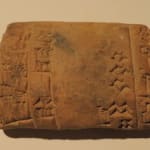Sumerian Cuneiform Tablet, 2080 BCE - 2010 BCE
Terracotta
2.25 x 3
LSO.1030
Further images
Sumerian cuneiform is one of the earliest known forms of written expression. First appearing in the 4th millennium BC in what is now Iraq, it was dubbed cuneiform (‘wedge-shaped’) because...
Sumerian cuneiform is one of the earliest known forms of written expression. First appearing in the 4th millennium BC in what is now Iraq, it was dubbed cuneiform (‘wedge-shaped’) because of the distinctive wedge form of the letters, created by pressing a reed stylus into wet clay. Early Sumerian writings were essentially pictograms, which became simplified in the early and mid 3rd millennium BC to a series of strokes, along with a commensurate reduction in the number of discrete signs used (from c.1500 to 600). The script system had a very long life, and was used by the Sumerians as well as numerous later groups – notably the Assyrians, Elamites, Akkadians and Hittites – for around three thousand years. Certain signs and phonetic standards live on in modern languages of the Middle and Far East, but the writing system is essentially extinct. It was therefore cause for great excitement when the ‘code’ of ancient cuneiform was cracked by a group of English, French and German Assyriologists and philologists in the mid 19th century AD. This opened up a vital source of information about these ancient groups that could not have been obtained in any other way. Cuneiform was used on monuments dedicated to heroic – and usually royal – individuals, but perhaps it’s most important function was that of record keeping. The palace-based society at Ur and other large urban centres was accompanied by a remarkably complex and multifaceted bureaucracy, which was run by professional administrators and a priestly class, all of whom were answerable to central court control. Most of what we know about the way the culture was run and administered comes from cuneiform tablets, which record the everyday running of the temple and palace complexes in minute detail, as in the present case. The Barakat Gallery has secured the services of Professor Lambert (University of Birmingham), a renowned expert in decipherment and translation of cuneiform, to examine and process the information on these tablets. His analysis is presented here. Clay tablet, 77 x 54 mm, with 12 lines of Sumerian Cuneifor This is written in a very large, clear hand, but while its general content and purpose is clear, in detail it is very difficult. It is not dated, but sign-forms and content, also spelling conventions, assign it to the period of the Third Dynasty of Ur, c. 2080-2010 BC. It is a list of areas of irrigated farmland cultivated by the town (or village) Pappas, not otherwise known. They are classified according to the quality of the land in each category, but while some of the terms are known elsewhere, their meanings mostly elude us. Each category is assigned a total area with a system of measures specified as “iku”, but the figures are complex and consist of multiples of 6, 18, 10 and 60. The result us that by our calculations (adding up the various figures given) the total given is somewhat out. Translation:
1780 ik 642 iku…
296 iku…
103 iku…
Adgula fiel 902 ik 14 ik Sikalla fiel 3324 ik Dabbanin fiel Mr Nissaba-andul, manage Field of the town Pappas. The land belonged either to a temple or to the palace, in either case it was under government direction and was thus under state bureaucrats, who kept control by rigorous checks, in this case giving classifications to the arable land according to its quality, and by measuring each type so that the yields at harvest could be kept under close supervision. But it appears that their figures are a little out. Since reading and writing was very restricted in this civilization, they did not need to worry too much over such slips: only they would be able to read their documents. An iku is 3530 square metres, about.
1780 ik 642 iku…
296 iku…
103 iku…
Adgula fiel 902 ik 14 ik Sikalla fiel 3324 ik Dabbanin fiel Mr Nissaba-andul, manage Field of the town Pappas. The land belonged either to a temple or to the palace, in either case it was under government direction and was thus under state bureaucrats, who kept control by rigorous checks, in this case giving classifications to the arable land according to its quality, and by measuring each type so that the yields at harvest could be kept under close supervision. But it appears that their figures are a little out. Since reading and writing was very restricted in this civilization, they did not need to worry too much over such slips: only they would be able to read their documents. An iku is 3530 square metres, about.







